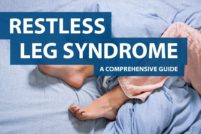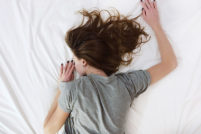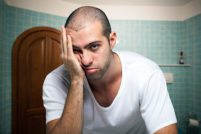But what is behind this bizarre nighttime behavior? And what can you do to help manage sleepwalking?
What Is Sleepwalking?
Sleepwalking (or somnambulism) is a behavioral sleep disorder that causes people to walk or perform other activities while asleep.
Episodes of sleepwalking typically happen during deep sleep, or during the transition from deep sleep to a lighter stage. It’s not associated with REM (rapid eye movement) sleep, as during that stage your body is effectively paralyzed.
It can be very difficult to wake up a sleepwalker, since they typically remain in deep sleep throughout the duration of the episode. This also means most sleepwalkers have very little memory of what they were when awoken.
What Does Sleepwalking Look Like?
Although we refer to it as “sleepwalking,” somnambulism usually causes people to do much more than just walk during their sleep. The disorder actually involves several complex behaviors that can including sitting up in bed, eating, or even driving.
Sleepwalking Symptoms in addition to walking:
- Sitting up in bed with open eyes
- Sleeptalking
- Glassy-eyed expression
- Performing routine activities (getting dressed, cooking)
- Unresponsive
- Screaming (if occurring along with sleep terrors)
- Hard to awaken
- Disorientation/confusion upon awakening
- Return to sleep quickly
- Little or no memory of the event
You’ve likely heard that you should not try and wake up a sleepwalker; however, this is a common misconception. Waking up a sleepwalker will cause them no harm, and can help protect them from having an accident.
On rare occasions, someone who is sleepwalking will:
- Leave their house
- Drive a car
- Exhibit inappropriate behavior (i.e. urinating, this is more commonly seen in children)
- Perform sexual activities without awareness
- React violently (either during the episode or upon awakening)
How Common Is Sleepwalking?
Sleepwalking is not that common in adults, with the overall prevalence in the general population falling between 1% and 15%.Children are far more likely to sleepwalk, with the highest prevalence of the sleep disorder occurring in three to seven year-olds. Additionally, children who experience bedwetting have a higher instance of sleepwalking.
Whether your child is sleepwalking, or you yourself have suddenly began to experience episodes in adulthood, the disorder is rarely cause for concern. There are many common experiences that may trigger sleepwalking.

via behance.net
What Causes Sleepwalking?
There is no one singular cause of sleepwalking; rather, the disorder has been associated with a wide variety of triggers. What these all have in common is that they affect the quality of your sleep.Interestingly, sleepwalking appears to run in families.
If one of your parents or siblings is a sleepwalker, you’re 10 times more likely to experience episodes yourself.
What triggers sleepwalking?
Sleep deprivation & Fatigue: Being overly tired, whether due to a lack of sleep or overworking, has been associated with a higher probability of sleepwalking.
Stress: Studies have shown that when stressed sleepwalkers tend to experience more frequent episodes.
Anxiety & Depression: Similarly to excessive stress, anxiety and depression often affect the quality of our sleep.
Sleep schedule disruptions: Sudden changes in sleep schedules, due to jet lag and shift work, throw off our circadian rhythms and can trigger sleepwalking.
Certain medications: Medications that affect sleep, such as hypnotics, sedatives, neuroleptics, stimulants, and antihistamines, may increase sleepwalking episodes.
Alcohol: Alcohol is known to induce sleepwalking, even in those who don’t experience episodes otherwise.
Physical conditions associated with sleepwalking
- Heatburn
- Fever
- Asthma
- Seizures
- GERD (gastroesophageal reflux disease)
- Migraines
- Obstructive sleep apnea
- Narcolepsy
- Restless leg syndrome
- Psychiatric disorders (PTSD, panic attacks, dissociative disorders)
Should I See My Doctor?
Although sleepwalking is typically a harmless condition that will resolve on it’s own, under certain circumstances it can help to discuss your disorder with your doctor or a sleep specialist.
If you (or your child) is experiencing the following, make an appointment to consult with a doctor:
- Episodes occur often (2+ times per week)
- Performing dangerous behaviors, or suffering injuries
- You experience your first episode as an adult
- Sleepwalking continues to occur into teenage years
- Episodes are causing significant sleep disruption in household
Your doctor or pediatrician will help you pin down what is triggering the episodes of sleepwalking, and rule out any underlying medical causes that may require treatment for the disorder to resolve.
Possible Treatments For Sleepwalking
If your sleepwalking is significantly disrupting your life and is associated with negative consequences (such as injury), your doctor may choose to treat your condition medically.
Medical Treatments of Sleepwalking
Addressing the underlying condition: If your sleepwalking coincides with another sleep disorder, or one of the medical conditions listed above, treating these will help relieve your episodes.
Change your medications: If you’re on a medication that interferes with your sleep, altering these meds can help resolve sleepwalking.
Prescribe medication: Benzodiazepines and some antidepressants can help reduce episodes of sleepwalking. However, prescriptions should only be used if other attempts that reducing your symptoms have failed.
Hypnosis
Studies have demonstrated that sleepwalking can be successfully treated through the use of clinical hypnosis alone. Hypnosis is believed to help increase feelings of relaxation, reduce stress and improve sleep.As an alternative to visiting a clinical hypnotist, many people have had similar success in relieving their symptoms by learning self-hypnosis.
SelfHypnosis.com offers self-hypnosis audio recordings than you can purchase in MP3 format, or order as a CD. They have one designed specifically to help resolve sleep walking, but if you think anxiety or stress is at the route of your problem those clips may also be of help.
What Can I Do To Prevent Sleepwalking?
There’s no sleepwalking-specific treatment; instead, most people experience relief by practicing good sleep hygiene. This entails adjusting your daily routine, and establishing healthy habits in order to help promote the best quality sleep.
Identify a Pattern
Someone close to a sleepwalker can keep a diary of their symptoms for a few days, and then this information can be used to identify a pattern in their episodes (if one exists).
If there is a clear pattern in how long after falling asleep the sleepwalker experiences an episode, you can practice “anticipatory awakenings”. This requires waking up the sleepwalker approximately 15 minutes prior to when they usually sleepwalk.
Keep them awake for around five minutes, then go back to sleep. Often this is enough to prevent the episode all together.
Stay Safe
While working on resolving yours or your child’s sleepwalking episodes it’s important to ensure that your home is safe for sleepwalking.
- Don’t allow children to sleep in bunk beds
- Remove any sharp or breakable objects from around the bed
- Lock doors and windowsInstall gates on stairways
- Remove any tripping hazardsInstall alarms or bells on doors
- Sleep on the ground floor of your home





